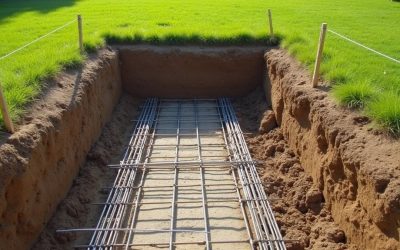Solar flood lights are a great way to light up your outdoor space while being environmentally friendly and cost-effective. They provide a bright and reliable source of illumination for any outdoor area, from your backyard to your driveway. If you’re unfamiliar with them, you’re probably wondering if they really work.
Yes, solar floodlights do work as long as they are placed in an area with sufficient sunlight exposure to recharge the batteries. They are a great energy-efficient option for outdoor lighting and can provide bright illumination for security purposes.
With so many options on the market, it can be difficult to determine which solar flood lights are best for your needs. In this article, we’ll look at how to choose the best solar flood lights for your outdoor space.
What are Solar Flood Lights?
Solar flood lights are the perfect way to light up your outdoor areas without having to worry about running up your electricity bills.
These lights rely on energy from the sun, meaning you won’t need to worry about finding a power source or needing additional wiring.
Solar flood lights come in a variety of styles and sizes, so you can choose one that best fits your needs. With features such as remote control, dawn light, and motion sensor flood light, you can customize your lighting setup to suit you.
Plus with their bright white light output and long-lasting battery power, solar flood lights are sure to provide an effective level of illumination for years to come.
Why use solar floodlights?
Solar floodlights offer a great way to light up your outdoor space with minimal cost and effort. Let’s take a closer look at why you should consider using them.
1. They are environmentally friendly
Solar floodlights help the environment by reducing the need for energy from power plants, thereby reducing carbon emissions. They make use of a renewable, free source of energy .
2. They are inexpensive
The cost of solar flood lights varies depending on the type, size, and features of the light. Generally, a basic solar flood light can range from around £30 to £150, while more advanced models can cost up to £500. Other factors such as wattage, LED brightness, and water-resistance can also affect the price. Comparatively, traditional flood lights typically cost much more than solar flood lights.
3. They are easy to install
As they don’t require hard wiring into mains power, solar lights are incredibly easy to install compared to traditional lights.
All components for installation are typically included in one box, you’ll just need to gather the necessary tools, like a drill and screwdriver, and decide on the best location for the flood light.
To install you’ll attach the light to the chosen location and place the solar panel in a spot where it will be exposed to the most direct sunlight.
To keep the system running efficiently, it’s recommended to clean the solar panel and light every couple of years.
Once installed, it works by gathering the energy of the sun through the solar panel, which is usually mounted in a spot that gets the most sunlight. This energy is then stored in batteries, allowing the light to create light even when the sun isn’t shining.
At night, the energy stored in the batteries is converted into light by the LED bulbs. The LED bulbs provide bright illumination, making solar flood lights an ideal option for outdoor lighting. As the solar light is completely wireless and does not require any wiring, it is incredibly easy to install and maintain.
Overall, solar floodlights are an excellent option for outdoor lighting. They are both cost-effective and eco-friendly, harnessing the energy of the sun to create bright, reliable illumination without any wiring.
5. They provide bright light
You might be surprised to learn that solar flood lights offer bright light through the use of light-emitting diodes (LEDs) that cast intense beams of light without drawing a lot of power or creating heat.
The intensity of a solar light’s illumination is measured in lumens, and generally speaking, the higher the lumens, the brighter the light.
For example, a standard 100-watt incandescent bulb produces about 1,600 lumens, while one of today’s solar flood lights might produce up to 28,000 lumens.
Additionally, the breadth of the beam also plays a role in the light’s brightness; the narrower the beam, the brighter it will seem. Solar flood lights can be used to cast light over a 50- to 280-degree arc outward from the light itself, illuminating a narrow walkway or a large backyard area.
6. They are weatherproof
As they’re designed for outdoor use they generally have an IP (Ingress Protection) rating. This rating is a two-digit number that ranks the light’s resistance to dust and water.
The first number, which ranges from 1 to 6, indicates how well the light can resist solid items such as dust, with 6 providing the highest level of protection.
The second number, which ranges from 1 to 8, shows how well the light can resist water, with 8 being completely waterproof. The higher the rating, the more resistant the light is. Most flood lights have ratings ranging from 65 to 67.
In addition to the IP rating, most solar flood lights also come with various components that can help protect them further. For example, motion sensors can detect when it is dark and turn the lights on or off accordingly, while some lights come with dust-proof covers that can help keep them safe from the elements.
Overall, it is important to consider the IP rating and other protective components of solar flood lights in order to ensure that they stay weatherproof and last longer. With the right protection, these lights can provide long-lasting, efficient illumination in any environment.
7. They are movable
Thanks to being wire free, solar flood lights are designed to be movable and can be easily repositioned if required.
If the product required hard-wiring into the mains it would be very difficult to move to a new location as you wouldn’t just be moving the light, you’d also be moving the mains supply wiring.
What to consider when choosing a solar flood light?
When it comes to choosing the right solar flood light for your home or business, there are a few key factors to consider.
1. Quality of Light
When choosing a solar flood light, it is important to consider the quality of light. The intensity of light is determined by lumens and the higher the lumens, the brighter the light will be.
For example, a standard 100-watt incandescent bulb produces about 1,600 lumens, whereas a night-light only produces about 20 lumens.
The coverage distance is also an important factor to consider, as it will determine how far the light can reach and how large of an area can be illuminated.
Additionally, the type of solar panel used, battery type and capacity, wattage, bulb type, and color temperature all come into play when selecting the best solar flood light.
The brightness of the light should be chosen according to the area it is meant to illuminate. For smaller and accent lights, the lumen rating should be between 100 – 300 lumens, whereas for larger areas, the lumen rating should be between 1000 – 3000 lumens.
Motion activated solar flood lights should have a lumen rating of 300 – 600 lumens. Lastly, choosing a product with certifications that can stand up against dust and moisture is important to ensure that the light can withstand any outdoor weather conditions.
2. Cost of Light
Price is always an important factor to consider. The brand and the features all feed into the final price, so consider your budget and what features you really need.
In conclusion, when selecting a solar flood light, there are many price considerations to keep in mind. It is important to consider several factors like wattage, coverage area, and battery capacity in order to find the best light within your budget.
3. Size and Weight
When selecting a solar flood light, size and weight are important considerations. The LED diodes are small light sources and won’t take up a lot of space in LED floodlight fixtures, ranging from 5X5 inches to 20X20 inches.
However, the panels of the solar-powered floodlights are bigger and wider than LED flood lights and will take up more space for installation.
In terms of weight, the heavier the floodlight is, the better, as this indicates that the materials used are of higher quality and can withstand the elements better.
Additionally, one should also consider the light energy amount in lumens. High-powered solar flood lights can produce sufficient brightness to illuminate the entire lawn or area, while others may only cover a smaller door area.
4. Mode and Time Light
Solar flood lights offer a variety of modes and times to choose from, for example:
Security Mode keeps the lights in 10% power until motion is detected, while the full brightness mode can operate for up to 8 hours before needing to charge again.
Motion Sensor Mode will only turn on full brightness when motion is detected, while the Timer Mode allows you to control the length of time the lights remain on.
Dusk-to-Dawn Mode will turn the lights on automatically at dusk and off at dawn, while the Manual Mode allows you to turn the lights on and off manually.
Different settings will cause the lights to run for different lengths of time, usually ranging from 3-8 hours on a full charge.
5. Waterproofing
The importance of waterproofing when choosing a solar flood light cannot be overstated. Waterproofing is essential for ensuring a light’s longevity, functionality and safety. Without it, the light could be damaged due to exposure to moisture, leading to a decrease in performance and even a potentially dangerous electrical hazard.
Additionally, a light that is not waterproof will not be able to withstand extreme weather conditions, such as rain, snow or high winds, which could cause the light to malfunction or even fail completely.
Therefore, when selecting a solar flood light, it is essential to check the IP rating to ensure the light provides sufficient waterproofing and protection from the elements.
6. Security Features
Motion sensors are a key feature as they will detect movement and turn on the flood light immediately. Adjustable motion sensors are ideal, as they can be set to pick up motion from both people and smaller animals like raccoons.
Brightness and timer options should also be taken into account, as you’ll want to make sure that the light is bright enough for security purposes and that it will stay on for the desired amount of time.
Additionally, security cameras can be used in conjunction with lights to capture any movement in the area. This is particularly useful for larger areas that need to be monitored.
7. Angle of Illumination
A narrower beam of light will create a brighter effect and is perfect for narrow passageways.
A wider beam of light will spread the light out over a larger area, and would be better for driveways and gardens.
FAQs
What are the main features of the best solar flood lights?
The main features of the best solar flood lights include adequate levels of brightness, long battery life, capacity to charge fully during the day, and certifications to stand up against dust and moisture.
How does motion sensor technology work in solar flood lights?
Motion sensor technology works in solar flood lights by scanning infrared heat changes to detect motion in the monitored area.
The motion sensors typically have adjustable settings including the detection range, distance, light sensitivity and delay time.
The detection range and distance setting determines the angle at which the motion sensor will detect motion, with some motion sensors detecting motion within a 180-degree angle, while others detect motion in a 360-degree angle.
The light sensitivity setting determines the darkness level at which the sensor will start to detect motion, as the sensor will only start working at night and will stop during the day.
The delay time setting determines the amount of time after the motion has been detected that the light will stay illuminated.
Additionally, lights with remote control settings allow the user to turn the lights on and off without having to manually do so.
What is the highest lumen rating for a solar flood light?
The highest lumen rating for a solar flood light is 12,000 lumens. Lumens measure the amount of light energy that a bulb produces and are typically expressed in terms of wattage.
Higher wattage means more lumens, which usually translates to a brighter light. For example, a 23-watt solar floodlight could generate up to 1,500 lumens while a higher-powered floodlight can generate up to 5,920 lumens or even 12,000 lumens.
The higher voltage (7.4 Volts or more) floodlights usually have longer life and higher lumens, and are powered by Lithium-ion batteries. Lower-voltage (around 6-Volts) floodlights are typically powered by a couple of Ni-MH batteries.
How long do solar flood lights last?
Solar flood lights can last for a very long time if they are high quality, waterproof, weatherproof, heat-resistant, and frost-resistant. The LED lights have a lifetime usage of about 100,000 hours of run time, so they can be used for over 8,000 nights. The battery cycles and weather extremes can affect the longevity of the solar light, but on average, you should be able to get 50,000 hours of light out of it. The run time of solar flood lights can vary depending on the charge, the settings, and the light design. Generally, dim settings and motion sensing settings consume less energy, thus providing extended run times.
Final Thoughts
Solar flood lights offer a great way to secure your property and add light to the outdoors. With their long life, bright lights, and motion sensing technology, they are an ideal choice for any property.
With their long battery life and capacity to charge during the day, these solar flood lights can help you protect your home or business while utilizing renewable energy sources.


